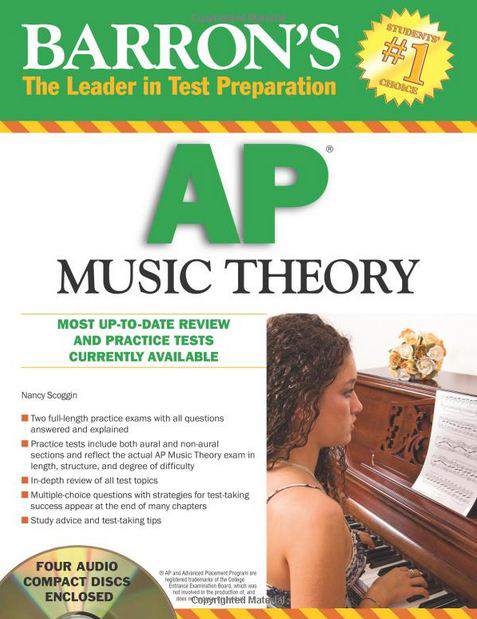

Sepand Shahab
Part Writing Root Position Triads
Slide Duration:Table of Contents
Section 1: AP Music
Note Reading
12m 37s
- Intro0:00
- Lesson Objectives0:10
- Note Names on the Keyboard and Staff0:30
- Helpful Tip to Remember0:37
- Memory Aids3:46
- Ledger Lines5:41
- Example 17:21
- Example 29:29
- Example 310:23
- Example 411:20
Scales
23m 25s
- Intro0:00
- Lesson Objectives0:07
- Whole Steps & Half Steps0:36
- Whole Steps1:31
- Half Steps1:37
- The Major Scale3:31
- Minor Scales 1: Natural Minor5:07
- Natural Minor Starts Here5:31
- Write Notes on Staff5:45
- Minor Scales 2: Harmonic Minor7:11
- G Sharp7:27
- Write Notes On Staff8:04
- Minor Scales 3: Melodic Minor8:12
- Descending Form on Scale9:29
- Ascending Form on Scale10:02
- Write Notes on Staff10:27
- Melodic Minor Ascending: Whole & Half Step Pattern11:10
- Melodic Minor Descending: Whole & Half Step Pattern11:51
- Example 112:29
- Example 215:41
- Example 318:31
- Example 420:56
Key Signatures
18m 41s
- Intro0:00
- Lesson Objectives0:07
- Why Key Signatures?0:45
- Using Scale Patterns to Find Key Signatures2:50
- Major Scale Reminder3:00
- The Circle of Fifths5:36
- Example 111:41
- Example 213:52
- Example 315:34
- Example 417:37
Intervals
33m 19s
- Intro0:00
- Lesson Objectives0:07
- Definition0:28
- What Is An Interval?0:32
- Melodic Example1:00
- Harmonic Example1:07
- Interval Numbers1:30
- Compound Interval2:49
- Interval Spellings3:26
- Number & Note Name3:45
- Interval Qualities5:24
- Major Scale6:35
- Perfect7:14
- Minor7:38
- Interval Alterations8:55
- Augmented Interval9:42
- Diminished Interval10:11
- Chart to Remember Interval Sizes10:22
- Using Key Signatures to Find Intervals10:49
- Practice Example: Major12:03
- Practice Example 2: Major12:30
- Practice Example: Minor 3rd12:59
- Practice Example: Minor 6th13:33
- Practice Example: Minor 7th13:53
- Using Key Signatures to Find Intervals, Part 214:13
- Example: Major 3rd Above D Sharp14:28
- Example: Minor 6th Above G Flat15:42
- Inverting Intervals16:45
- What Major, Minor & Perfect Becomes18:20
- Example 119:09
- Example 222:42
- Example 324:35
- Example 430:33
Triads
26m 11s
- Intro0:00
- Lesson Objectives0:07
- Triads in Major0:30
- Quality of Triads2:09
- Upper Case = Major Triads2:17
- Lower Case = Minor Triads2:28
- Example: E Major2:55
- Tonic Degree4:09
- Supertonic Degree4:13
- Mediant Degree4:21
- Subdominant4:28
- Dominant4:35
- Submediant4:40
- Subtonic4:49
- Triads in Minor5:47
- a Minor5:55
- d Minor6:58
- Major Triads8:04
- Construct Major Triad: E flat9:22
- Construct Major Triad: D Flat10:55
- Minor Triads11:44
- Construct Minor Triad: F Sharp12:30
- Diminished Triads14:02
- Find Diminished Triad in B Major15:02
- Find Diminished Triad in B Minor16:00
- Augmented Triads16:49
- Structure17:12
- Turn E Major Chord Into Augmented Triads17:39
- Turn A Minor Chord Into Augmented Triads18:52
- Example 120:08
- Example 221:11
- Example 322:52
- Example 424:19
Seventh Chords
19m 42s
- Intro0:00
- Lesson Objectives0:07
- Seventh Chords in Major0:26
- Seventh Chords in Minor2:56
- Minor, Major, Dominant, Diminished4:44
- Major Seventh Chords5:33
- Practice6:07
- Minor Seventh Chords7:10
- Practice7:35
- Dominant Seventh Chords8:38
- Practice9:10
- Diminished Seventh Chords10:14
- Half-Diminished Seventh Chord10:55
- Practice11:17
- Half-Diminished Seventh Chords12:22
- Example 113:50
- Example 214:58
- Example 315:57
- Example 417:14
Inversions of Triads
17m 27s
- Intro0:00
- Lesson Objectives0:07
- First Inversion Triads0:25
- Root Position0:54
- Invert Chord1:05
- First Inversion Chord1:24
- Example With Minor Chord2:00
- Second Inversion Triads2:38
- Example With Diminished Chord3:30
- Figured Bass Symbols4:27
- Example With C Major6:23
- Example With 2nd Minor7:18
- Example With 2nd Inversion8:51
- Example 110:01
- Example 211:06
- Example 312:26
- Example 414:22
Inversions of Seventh Chords
19m 11s
- Intro0:00
- Lesson Objectives0:07
- First Inversion Seventh Chords0:30
- Start w/ Root Position Chord0:39
- Review Third Chord In Base1:48
- Second Inversion Seventh Chords2:01
- Example: Minor Seventh Chord2:59
- Third Inversion Seventh Chords3:43
- Example: E Major Seventh Chord5:14
- Figured Bass Symbols6:32
- Example: Third Inversion Seventh Chord8:55
- Another Example9:43
- Example 1 (Practice Problem)10:44
- Example 213:03
- Example 315:48
- Example 417:15
Part Writing Root Position Triads
24m 41s
- Intro0:00
- Lesson Objectives0:08
- Roots a 4th Apart0:37
- Rule 1 to Keep In Mind1:24
- Rule 2 to Keep In Mind1:54
- Practice Example4:16
- Practice Example5:40
- Roots a 3rd Apart8:47
- Practice Example11:07
- Roots a 2nd Apart11:57
- Practice Example14:20
- Practice Example15:34
- Example 116:20
- Example 218:00
- Example 320:03
- Example 422:10
Voice Leading
18m 24s
- Intro0:00
- Lesson Objectives0:09
- Voice Ranges0:38
- Soprano Voice1:04
- Alto Voice1:11
- Tenor Voice1:20
- Bass Voice1:29
- Parallel Motion2:07
- Similar Motion3:55
- Definition4:16
- Example:Contrary Motion4:46
- Oblique Motion6:03
- Definition6:09
- Open and Closed Spacing6:51
- Closed Spacing Definition7:40
- Open Spacing Definition8:56
- Common Voice Leading Errors10:15
- Parallel Octaves10:34
- Parallel Fifths11:22
- Spacing12:18
- Completed Chords13:48
- Taking Over Other Voices14:31
- Voice Crossing15:25
- Example 115:41
- Example 216:09
- Example 316:51
- Example 417:38
Cadences
15m 4s
- Intro0:00
- Lesson Objectives0:06
- Perfect Authentic0:30
- Example: Perfect Authentic Cadence Minor1:39
- Imperfect Authentic3:05
- Definition4:00
- Half Cadence4:42
- Definition4:53
- Example: Half Cadence in Minor5:30
- Plagal Cadence6:49
- Example: Plagal Cadence in Minor7:49
- Deceptive Cadence8:25
- Definition8:30
- Example: Deceptive Cadence in Minor9:52
- Example 111:01
- Example 212:02
- Example 312:59
- Example 413:45
Part Writing First Inversion Triads
25m 10s
- Intro0:00
- Lesson Objectives0:09
- Substituting First Inversion Chords0:35
- Main Use of First Inversion Chord1:24
- Parallel First Inversion Chords6:01
- First Inversion Chords in Sequence9:48
- Example 113:11
- Example 216:46
- Example 320:35
- Example 422:30
Part Writing Second Inversion Triads
17m 14s
- Intro0:00
- Lesson Objectives0:08
- Passing Second Inversion Chords0:28
- Start At Base Line0:58
- Neighboring Second Inversion Chords3:03
- Why It's Called Neighboring3:48
- The Cadential Second Inversion Chord4:28
- Tips to Remember6:47
- Arpeggiating Bass Second Inversion Chords7:12
- Example 18:33
- Example 210:52
- Example 313:11
- Example 415:01
Non-Harmonic Tones
24m 16s
- Intro0:00
- Lesson Objectives0:07
- Passing Tones0:28
- Practice Example3:19
- Neighboring Tones4:48
- Suspensions6:27
- 3 Parts6:54
- Appoggiaturas12:15
- Defined As Approggiaturas Because…13:50
- Pedal Point14:15
- Definition15:54
- Example 116:15
- Example 218:18
- Example 320:22
- Example 421:22
Part Writing Seventh Chords
25m 28s
- Intro0:00
- Lesson Objectives0:08
- Preparing and Resolving the 7th0:42
- Example With Minor Key3:30
- V7 and Its Inversions6:03
- Difference Between V7 & Other Seventh Chords6:10
- Seventh Chords in Sequence9:55
- Example 115:16
- Example 218:21
- Example 320:13
- Example 422:02
Secondary Dominants & Leading Tone Chords
27m 9s
- Intro0:00
- Lesson Objectives0:10
- Dominants and Secondary Dominants0:34
- Definition1:16
- Practice Example3:19
- Leading Tone and Secondary Leading Tone Chords6:09
- Example: Minor Key Note6:25
- Practice Example8:31
- A Progression with Secondary Dominants9:41
- Start With Basic Progression10:07
- Where Can You Introduce Secondary Dominants11:01
- Embellish With Another Secondary Dominant12:40
- A Progression with Secondary Leading Tone Chords16:02
- Embellish with Secondary Leading Tone Chords17:13
- Example 121:43
- Example 222:50
- Example 324:10
- Example 426:07
Modulation to Closely Related Keys
28m 3s
- Intro0:00
- Lesson Objectives0:08
- Closely Related Keys0:27
- Relative Minor1:26
- Key Signatures2:05
- How to Tell Closely Related Keys2:50
- Example: F Major3:40
- Chords Common to More than One Key5:32
- Example: F Major6:42
- Which Chord 2 Keys Have in Common7:29
- Modulating with a Common Chord 19:03
- Modulating with a Common Chord 212:37
- Example 117:16
- Example 218:54
- Example 320:57
- Example 423:19
Phrases & Periods
38m 39s
- Intro0:00
- Lesson Overview0:09
- A Musical Phrase0:23
- Build Phrases2:07
- Focus on Base & Melody3:19
- Important Idea/ Summary of Phrases5:37
- The Form of a Period6:08
- Components of a Period6:23
- Practice: Write Out All the Harmonies10:03
- Writing a Period13:04
- Example 120:40
- Example 222:34
- Example 327:39
- Example 433:11
Binary & Ternary Forms
39m 15s
- Intro0:00
- Lesson Objectives0:08
- Binary Form Diagram0:29
- 2 Parts for Binary Form0:43
- Writing a Binary Form3:23
- Ternary Form Diagram16:47
- 3 Parts17:02
- Writing a Ternary Form19:19
- Example 124:41
- Example 228:28
- Example 332:09
- Example 435:35
Modes
14m 25s
- Intro0:00
- Lesson Objectives0:06
- Ionian Mode0:36
- Ionian Mode Placement0:56
- Dorian Mode1:26
- Dorian Mode Drawn On Scale1:38
- Where Dorian Differs From Ionian3:12
- Phrygian Mode2:39
- How Phyrgian Differs3:30
- Lydian Mode3:42
- Lydian Mode Compared to Major Scale4:18
- Mixolydian Mode4:40
- Mixolydian Mode Compared to Major Scale5:15
- Aeolian Mode5:29
- Locrian Mode5:54
- Locrian Mode Compared to Minor Key7:14
- Example 17:28
- Example 28:39
- Example 39:40
- Example 412:05
Loading...
This is a quick preview of the lesson. For full access, please Log In or Sign up.
For more information, please see full course syllabus of AP Music Theory
For more information, please see full course syllabus of AP Music Theory
AP Music Theory Part Writing Root Position Triads
Lecture Description
In this lesson, our Professor Sepand Shahab gives an introduction to part writing root position triads. He starts by discussing roots a 4th apart and some rules to keep in mind, then moves onto roots a 3rd apart as well as roots a 2nd apart. He finishes off with some examples.
Bookmark & Share
Embed
Share this knowledge with your friends!
Copy & Paste this embed code into your website’s HTML
Please ensure that your website editor is in text mode when you paste the code.(In Wordpress, the mode button is on the top right corner.)
×
Since this lesson is not free, only the preview will appear on your website.
- - Allow users to view the embedded video in full-size.
Next Lecture
Previous Lecture













































Start Learning Now
Our free lessons will get you started (Adobe Flash® required).
Sign up for Educator.comGet immediate access to our entire library.
Membership Overview